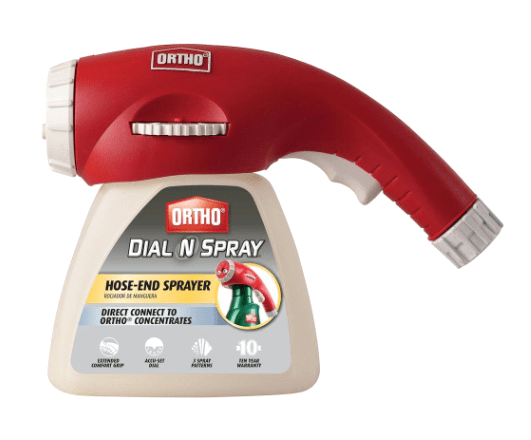(or… “How Much Do I Mix?”)
OK, so you bought a siphoning device or hose-end type sprayer, and even though you know you want to use 3/4 teaspoon of fertilizer per gallon, how do you mix it up?
In all cases, the formula is the same, but there may be a few twists:
(amount per gallon desired) x (ratio of proportioner) = (amount per gallon of concentrate)
Let’s start with the siphoning device:

Many siphoning devices have a fixed ratio, often 16:1. What that means is that the device will have a total output of 16 times the volume drawn through the chemical siphon hose. All you need to do is determine the final concentration and how much of that final solution you want (or how much of the concentrate you wish to mix up). The formula becomes:
(teaspoons per gallon desired) x (ratio of proportioner) = (teaspoons per gallon of concentrate)
So in our example, each gallon of concentrate will produce 16 gallons of final solution. So if we want 3/4 teaspoon per gallon, we will use 3/4 x 16 = 12 teaspoons of fertilizer to mix up one gallon of concentrate to be siphoned by the device.
Many folks will mix up 5 gallons of concentrate (as in the photo), so they would use 60 teaspoons (1.25 cups) of fertilizer to make up the 5 gallons. As long as you can keep the water from evaporating, it should be usable until it’s gone. For safety reasons, DO NOT mix up large volumes of pesticide concentrates and save them. Mix up only what you need for each application.
Now let’s at the metering pump:

The metering pump works a great deal like the siphon-type devices, but with the added benefits of being less dependent on flow rate (if at all), and the proportioning ratio can typically be changed over a wide range – some going as broad as 500:1 to 20:1, but a common setting is in the neighborhood of 128:1, or one ounce per gallon.
Going back to our base formula, but using the 128:1 example, each gallon of concentrate will produce 128 gallons of final solution, so if we want 3/4 teaspoon per gallon, we will use 3/4 x 128 = 96 teaspoons (2 cups) of fertilizer to mix up one gallon of concentrate.
Lastly, the hose-end sprayer:

The hose-end sprayers can be the most complex devices to use properly, as there are two variables – the tank is usually calibrated in ounces, and the output ratio can be adjusted. Both have to be taken into account when mixing up the concentrate.
Starting with the one-ounce-per-gallon (128:1) setting, each ounce of concentrate will produce one gallon (128 ounces) of final solution, so if we want 3/4 teaspoon per gallon, we will use 3/4 teaspoon of fertilizer for each ounce of concentrate in the tank. (If you are using a powdered fertilizer, add the powder first, then fill with hot water to the appropriate number of ounces.) Most of the tanks on these devices are one quart in volume (32 ounces), so have a maximum output per filling of 32 gallons at that mix ratio setting. We would make up the quart of concentrate with 32 x 3/4 = 24 teaspoons (1/2 cup) of fertilizer to give us our target rate of 3/4 teaspoon per gallon. However, the output volume can be changed by adjusting the mixing ratio.
Say you need about twice that volume of fertilizer for your collection. If you adjust it to 256:1, or one-half ounce per gallon, you now can get 64 gallons of final solution from that quart of concentrate. Keep in mind that if that adjustment is all that you did, the final solution is only half as strong, so you would need to double the amount of fertilizer used to make up the quart of concentrate.
The formula is the same as above:
(teaspoons per gallon desired) x (ratio of proportioner) = (teaspoons per gallon of concentrate)
So we’re looking at 3/4 x 256 = 192, but that’s teaspoons per gallon, and our tank is only a quart, so we would divide that by 4 to get 48 teaspoons, or one cup of fertilizer to make up the 32-ounce tank.
Keep in mind that there’s a solubility limit with fertilizers, so if you adjust the ratio for to high of a ratio, you would need more fertilizer than you could physically dissolve in the water. If your fertilizer solution needs are large, you would be better off getting a proportioning pump of some sort that feeds directly into your watering hose.